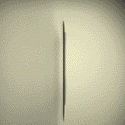
Brandon Roberts is the kind of composer who makes your palms sweat, your heart race, and—if you’re lucky—brings a tear to your eye. He’s an Emmy winner, a sound-sculpting sorcerer, and one of the most quietly dominant forces working in film and TV today. If you’ve screamed, gasped, or ugly-cried at anything from Free Solo to Star Wars: Andor, there’s a good chance Brandon’s music was pushing all the right buttons.
Roberts grew up in Carmel-by-the-Sea and graduated from USC’s famed Scoring for Motion Pictures & Television program and immediately started leaving his mark on everything from blockbusters to beautifully bleak horror indies. His résumé reads like a geek’s Criterion shelf: A Quiet Place I & II, Logan, World War Z, The Woman in Black (both of them), Warm Bodies, The Giver—and that’s before we even get to TV.
He’s brought emotional depth to Pantheon, espionage intrigue to TURN: Washington’s Spies, and full-throttle weirdness to Jordan Peele’s reboot of The Twilight Zone, which he co-scored with longtime collaborator Marco Beltrami. Their work on Free Solo didn’t just elevate the doc—it straight-up earned them an Emmy.
Lately, Brandon’s been on a tear. He scored Pet Sematary: Bloodlines (Paramount), Thanksgiving (Sony), On a Wing and a Prayer (MGM), and Land of Bad (hello, Russell Crowe with a military drone). He also just finished co-scoring Clown in a Cornfield (yes, that’s a real title and yes, it’s nuts in the best way), and the haunting Forgive Us All. Oh—and no big deal—he’s back in the galaxy scoring Season 2 of Andor, one of the most critically beloved pieces of Star Wars storytelling since Rogue One.
His signature? A seamless blend of orchestral elegance and industrial grit. He’s just as comfortable making you feel things on Yavin 4 as he is hammering out dread on a dulcimer in Gormon. His reverence for the Star Wars legacy (he legit got to use the OG 1977 snare drum, folks) and obsession with continuity make him the kind of composer we geeks dream about.
Take a listen to the soundtrack below:
How did you first approach scoring Andor?
I had the great benefit of coming into a world already shaped by what Nicholas Britell and Tony Gilroy had accomplished in Season One. Even though my score for Season Two ventures into new directions with new themes, it still honors the sonic palette they created. Honestly, a lot of the experimental groundwork was done in that first season. I was the lucky beneficiary of that.
Was there a moment from Season One that helped unlock the musical voice of the series for you?
I was already a fan of Nick’s work, so writing in that established palette felt very natural to me. It’s a hybrid score—electronic and synthesized elements combined with orchestra—which aligns with the type of music I’ve composed throughout my career. I have a soft spot for Mon Mothma’s theme; that was the emotional anchor for me in Season One. It all just clicked. When I began Season Two, it felt like: “Yeah, I can do this. This is my kind of show.”
The score has an industrial, mechanical quality at times. How do you creatively arrive at that tone?
That industrial vibe made immediate sense in Season One, especially with Ferrix’s blue-collar atmosphere. In Season Two, we travel more, so I had to adapt. For instance, I wrote a very Americana-inspired theme for Mina Rouse. For Yavin, I composed something that could feel at home in A New Hope—a nod to the original trilogy. A lot of it is instinctual.
I make musical decisions based on the setting, the emotional arcs of the characters, and a lot of discussion with Tony Gilroy, who has a strong and informed musical sensibility.
Cassian Andor’s character is layered and evolving. How did his arc influence your thematic choices?
A lot of my focus was on how and when to reintroduce Nick’s main theme for Cassian. I use it sparingly but deliberately—sometimes in heroic moments, other times subtly during introspection. The idea was to link Cassian not just to Season One, but to the series as a whole and his eventual fate in Rogue One. The story always dictates the music, but I was very intentional with when I brought back thematic elements.
What did you hope to bring to Mon Mothma’s character through music?
I loved every single scene she was in this season. Scoring them was a joy. Early on, it was more source music—like at the Chandelian wedding—but as the season progresses, her music becomes more central and varied.
Without spoiling anything, there’s espionage-driven scoring and moments of deep emotional tension. Her arc demanded a diverse musical approach, more so than any other character this season.
She’s truly in a pressure cooker—professionally and personally.
Exactly. She’s under constant pressure, and the stakes are incredibly high. That made her such a compelling character to score throughout the season.
Was there a moment while scoring that surprised you emotionally or creatively?
Episode 208 felt like a feature film—it’s epic in every way. I had been prepped for it, but watching it come together with the acting, VFX, and production design was overwhelming in the best way. That episode is a tour de force.
Were there particular instruments or textures you used to represent characters or settings?
Yes, we gave musical identities to different planets and characters. For Gorman, I used a cimbalom and hammer dulcimer—played with wood mallets—to establish its sonic signature. We also used found objects like metal and trash for texture.
Yavin, being under construction, has a raw soundscape. For the KX droids, we used big metal chains and trash can impacts. One special moment was using the original snare drum from the 1977 Star Wars score—it features prominently in Episodes 211 and 212. Touching that drum was surreal.
Did you feel any pressure fitting Andor into the larger Star Wars musical legacy?
Absolutely. You say yes, then immediately have a panic attack! This is Star Wars. You’re following in the footsteps of incredible composers—above all, John Williams. Eventually, you focus on what you can bring while still honoring the established style. I’m a stickler for musical continuity. The Empire Strikes Back is my favorite score of all time. I cared deeply about the project and was always conscious of how the music fit into the broader universe.
If you could score any legacy Star Wars moment or character, who would it be?
Honestly, the six-year-old in me would have loved to score the binary sunset scene. That moment with the Force theme is pure magic. It’s not about the character—it’s about the moment. That said, I did get to score a TIE Fighter chase, which felt like a dream come true.
You also worked on Clown in a Cornfield—quite a departure. What was that like?
Yes, a total 180—from the galaxy to the cornfield! It comes out next week. I co-scored it with my best friend Marcus Trumpp, and we had a blast. It’s super self-aware, chaotic, and just a ton of fun. Director Eli Craig was amazing to work with. It was a wild ride.
Who are your biggest musical inspirations?
No question—John Williams. I’m also a huge fan of Thomas Newman and Gabriel Yared. Mahler is another massive influence for me. But honestly, I listen to everything: film scores, classical, contemporary. The work being done by modern composers—across the board—is incredible.
What’s next for you?
I have a feature film coming out this summer called Forgive Us All. It’s a post-apocalyptic western shot in New Zealand—very dark, very heartfelt. I’m really proud of what we created. It’ll be in theaters this summer.
All episodes of Andor Season One and Season Two are currently streaming on Disney+.


The Geek is a working screenwriter, director and UCLA screenwriting instructor.
REELated:
What to know about Andor S1 before watching S2











